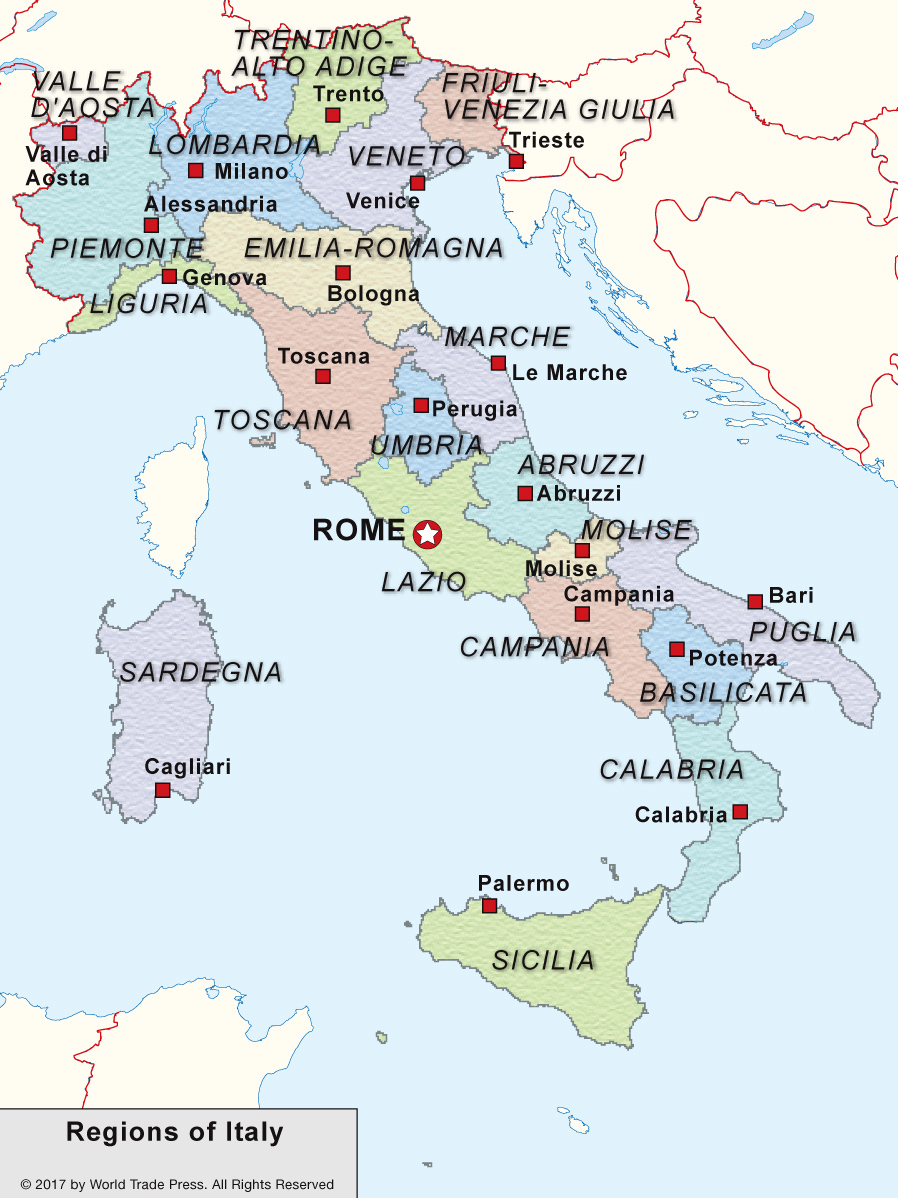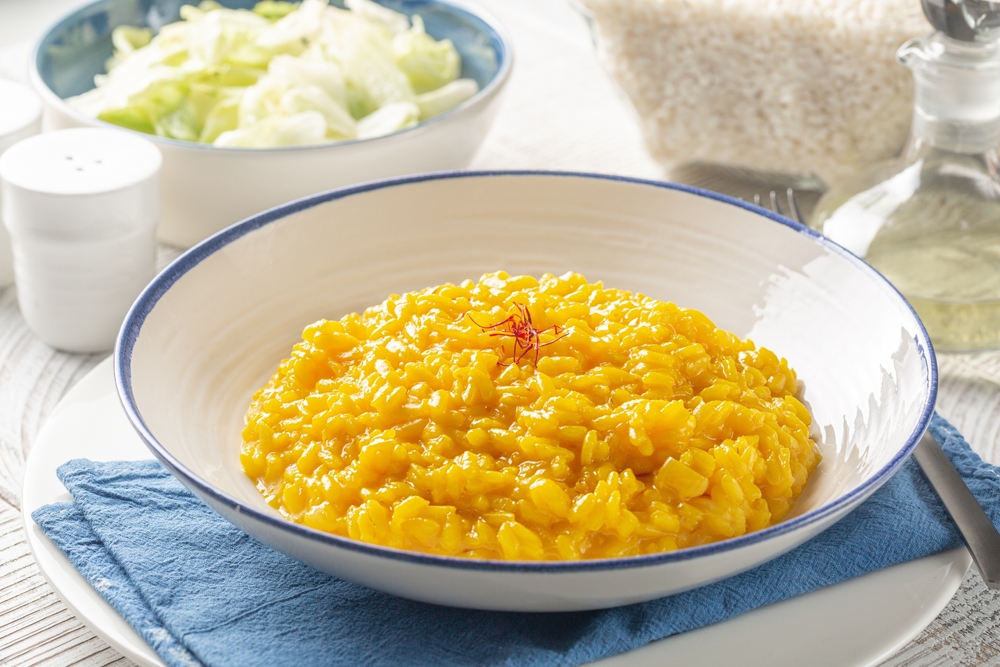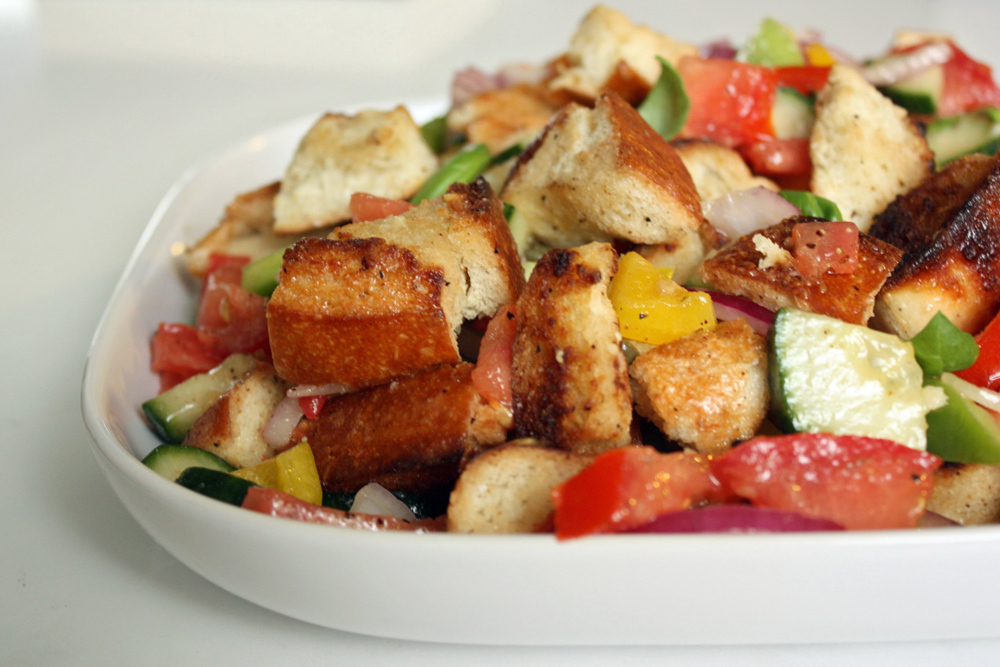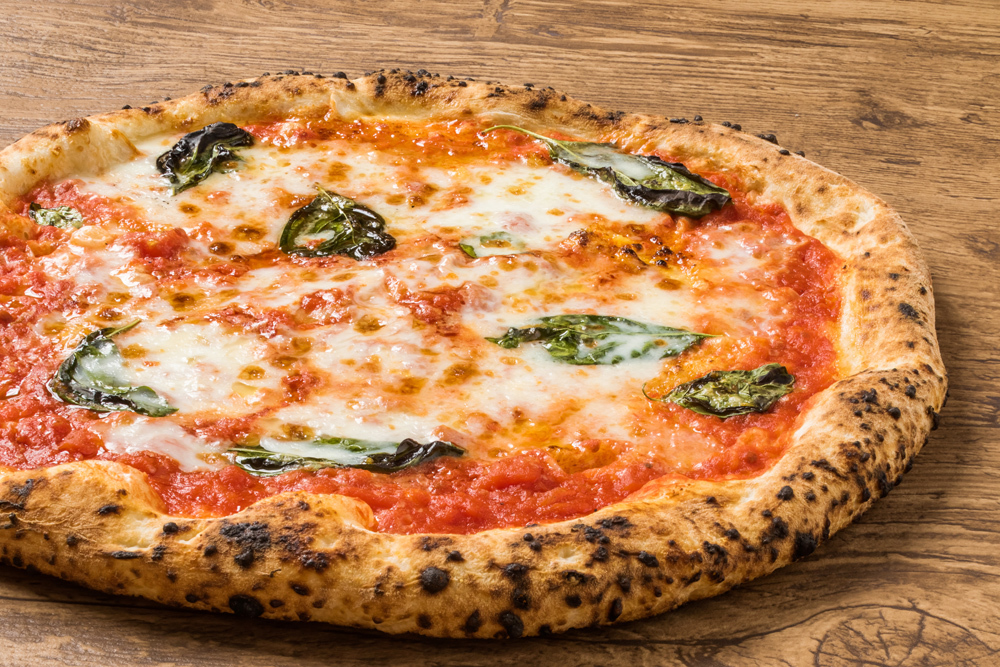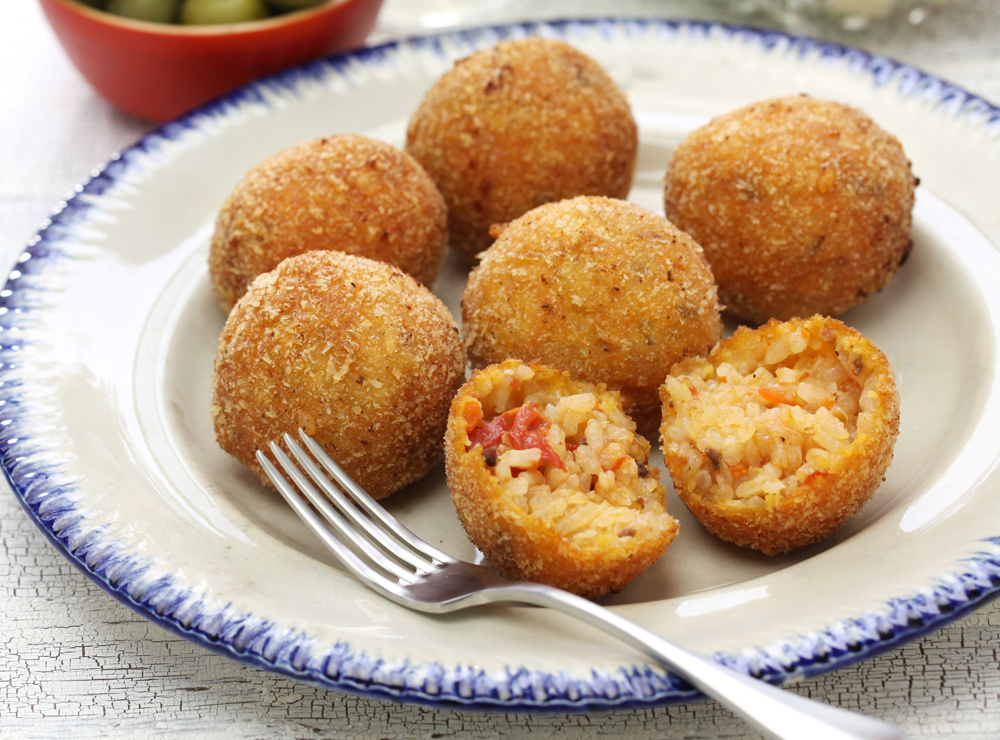Food and Drink: Regional Cuisine
Pizza and pasta may have come to epitomize Italian food, but as purists will assert, there is no such thing as a monolithic Italian cuisine: Italy contains a vast range of culinary traditions and at least twenty distinct regional cooking styles. From the fall of the Roman Empire through the mid-19th century, the Italian peninsula was a loose association of independent kingdoms and city-states, and it was this political, economic, and cultural fragmentation that contributed to the formation of diverse regional cooking styles and tastes.
North and South
In addition to culinary influences from neighboring countries in the Mediterranean, as well as France, Switzerland, and Austria to the north, Italian regional cuisines are flavored, broadly speaking, by geography, with a major distinction between the north and the south. The rugged north is colder and mountainous, and northern cuisines are subject to the seasonal availability of ingredients, while southern cuisines are shaped by a mild, fertile climate and year-round growing season. Accordingly, northern dishes tend to be heartier than the lighter Mediterranean fare of the south, and the north-south divide manifests in a general northern preference for risotto and polenta over pasta, butter and cream over olive oil, and meat over fish and beans. Despite these differences, the regional cuisines of Italy do share much in common, with each region having its own recipes for salumi (cured meats), cheese, wine, bread, and pasta.
Campanilismo
The prevailing sense of regionalism in Italy is perhaps best embodied in the term campanilismo, which refers to the devotion and pride one has for his or her ancestral region. The image comes from the campanile, a bell tower, which was traditionally the tallest building—the defining landmark—in a city or town. While modern Italian cuisine may be in a state of flux due to influences from global cuisine, immigration, and changing lifestyles, enjoying traditional foods remains an important expression of cultural identity and pride.
Culinary Regions of Italy
Lombardy
The northern Italian region of Lombardy is the wealthiest and most industrial region of Italy, producing about a fifth of the national GDP. With its long-standing industrial base, Lombardy has a vibrant tradition of manufacturing food products, from dried sausage to cheese, olive oil, and vinegar. The cultural and economic center of Lombardy is Milan, the sophisticated capital known for its haute cuisine.
Bordering Switzerland to the north, this region perhaps shares more in common with Central Europe than with Mediterranean Italy. Accordingly, its rich cuisine is heavy on red meat and pork, lard, and butter and cheese, with stereotypical “Italian” ingredients such as tomatoes, pasta, and olive oil seldom found in traditional Lombardian dishes. The plains of Lombardy are home to extensive cattle raising, and the region is renowned for its beef, veal, and Gorgonzola and Grana Padano cheeses.
Risotto alla milanese. Risotto is a staple of Lombardian cuisine, and risotto alla Milanese is the decadent dish of the sophisticated capital. Cooked with saffron, the risotto takes on a bright yellow hue. Yellow was historically considered a royal color, and saffron was included in recipes as a nod to the nobility.
Costoletta alla milanese. A breaded veal cutlet fried in clarified butter is similar to Wiener Schnitzel, though the Milanese version uses a bone-in cut of veal. The traditional recipe calls for milk-fed veal, which are raised on milk formula that gives the meat a velvety texture.
Ossobuco. A slow-stewed dish of veal shanks braised with white wine and vegetables, ossobuco is often served with risotto alla milanese or mashed potatoes.
Panettone. This fluffy, sweet bread loaf served at Christmastime is made of flour, candied fruits, and raisins and is thought to take its name from the phrase pan del ton, meaning “cake of luxury.” It is now eaten as a yuletide treat throughout Italy.
Cassoeula. This hearty, one-pot dish is a trusted wintertime standby of slow-cooked pork fat with cabbage, onions, carrot, and celery, served with polenta and red wine. This dish is traditionally prepared after the arrival of the first frost, which sweetens the cabbage.
Tuscany
The central Italian region of Tuscany is known for its romantic rolling landscapes, pastoral character, and deliciously down-to-earth culinary tradition. Though with its world-famous and well-visited capital at Florence, Tuscany is perhaps best known for its contributions to the artistic and scientific awakening of the Western world during the Renaissance. Tuscan cuisine, however, has much humbler origins.
Tuscan food is based on the concept of cucina povera, or “poor cooking.” Historically, Tuscan farmers toiled under the mezzadria legal system, a kind of sharecropping arrangement that required peasants to turn over half of their harvest to their wealthy landlords. This forced Tuscan farmers to get creative with what they had left over, and they devised ingenious uses for less desirable animal parts, legumes, and wild herbs.
Born of this pastoral history, Tuscan cuisine centers on rustic soups, breads, and slow-cooked stews. Most Tuscan recipes are simple and straightforward, hearty and satisfying, highlighting the flavors of high-quality local ingredients and seasonal produce. The flavors of Tuscany include pork and wild game, corn polenta, farro and rice, beans, mushrooms, olive oil, rosemary, and sage.
Pane toscano. Dating to the Middle Ages, when taxes made salt prohibitively expensive, peasants began baking unsalted bread. The practice remained long after the tax was lifted, and today, pane toscano is an accompaniment to practically every Tuscan meal. The pale, bland bread is ideal for soaking up the flavorful juices of traditional stews and soups.
Panzanella. One ingenious Tuscan recipe is panzanella, a salad of slightly stale bread and sun-ripened vegetables such as tomatoes, cucumbers, and onion. The olive oil and vinegar rehydrate the day-old bread for this substantial summer salad.
Lampredotto. This Florentine street food pays homage to the region’s love of offal. Lampredotto is a sandwich layered with abomasum, meat from the fourth stomach of the cow, chopped and slow-cooked in vegetable broth, served on a white bun with a tangy salsa verde.
Ribolitta. This Tuscan peasant soup is a hearty stew of leftover bread, cannellini beans, kale, cabbage, celery, potatoes, and onion. According to legend, the recipe came about during the Middle Ages, when servants would repurpose stale bread cleared from the tables of their masters for their own dinner.
Chianti wine. Tuscany has become synonymous with Chianti wine, made primarily with local red Sangiovese grapes. Chianti is often sold in a short, rounded bottle wrapped in a straw basket called a fiasco, and today, it is one of Italy’s most recognized export wines.
Bistecca alla fiorentina. This Florentine steak is no ordinary steak: it comes from the Chianina, a special cow breed, and is served extremely rare with beans and roasted potatoes. It is a go-to recipe for celebrations and holiday meals.
Veneto
Veneto is one of the northernmost regions of Italy, adjacent to Central and Slavic Europe. While it has strong ties with these regions, it maintains a character all its own, in part due to Veneto’s long history as one of Europe’s richest and most powerful early republics. Venice’s virtual monopoly on the spice trade from the 8th to 15th centuries introduced exotic—and expensive—ingredients imported from the Orient into the local cuisine, such as pepper, ginger, saffron, cinnamon, nutmeg, mace, and cloves.
Veneto is home to the second largest number of products holding an officially protected designation of origin (DOP) in Italy (after neighboring Emilia Romagna), including DOP Asiago cheese, Mortadella, and cultivars of radicchio and white asparagus. Typical ingredients in Venetian cuisine include polenta and rice, fish, beans, and grilled meats, particularly poultry.
Bigoli. These thick and coarse tube-like noodles are made of buckwheat and are often served with game or fish as a traditional first course. The Venetian recipe calls for an onion and salted sardine sauce, in a nod to the region’s dual influences of the interior plains and the coast.
Risi e bisi. Venice’s ultimate comfort food—rice and peas flavored with plenty of spices and fresh herbs—is somewhere between a risotto and a soup.
Polenta e osei. In this traditional dish, small songbirds such as larks are grilled on a spit and served with sage atop a bed of polenta. A sweet, vegetarian version sans songbirds is found in Venetian bakeries, with a candy bird perched atop a polenta sponge cake filled with hazelnut cream.
Pandoro. This spiced, sweet yeast loaf means “golden bread,” and was a favorite treat of the Venetian aristocracy. Only the wealthy could afford the expensive imported ingredients—such as sugar, as well as exotic spices like cinnamon, nutmeg, and saffron—used in the recipe.
Tiramesù. Not all traditional recipes have ancient origins: tiramesù, the Venetian-language word for the famous coffee-flavored custard dessert also known as tiramisu, is said to have originated at a restaurant in the Venetian city of Treviso in the 1960s, as a kind of sweet afternoon pick-me-up. It has since become the Italian dessert of choice across the world.
Lazio
The region of Lazio is home to the Italian capital of Rome, and though the imperial city has long been a center of power on the Italian peninsula, the city’s cuisine is more proletarian in nature. Lazian cuisine is noted for its use of inexpensive but flavorful cuts of meat and offal, local olive oil, beans, artichokes, salty and sharp Pecorino Romano sheep’s cheese, and fragrant fresh herbs like marjoram and mint.
The hinterland of the Eternal City is filled with rich agricultural valleys, which have supplied fresh meat and produce to Rome for millennia. Simple recipes showcasing the flavors of a few select ingredients mark Roman cuisine. Pasta is the dominant grain, with spaghetti and bucatini considered traditional shapes.
Abacchio alla romana. Rack of spring lamb, quickly pan-fried in olive oil and fragrant spices such as garlic, rosemary, and sage, topped off with salted anchovies. Abacchio is the centerpiece of many Roman celebrations, particularly at Easter.
Bruschetta. From the Roman dialect word bruschare, meaning “to roast over coals,” the traditional Roman bruschetta is a toasted appetizer of bread topped with chopped tomatoes, basil, and olive oil. It likely originated in ancient Rome, when olive farmers would bring their harvest to the local olive press and toast pieces of bread to sample the fresh oil.
Coda alla vaccinara. Rome’s preoccupation with offal is best embodied in the beloved coda alla vaccinara, oxtail stew cooked with vegetables. This humble dish comes from the ancient custom of paying butchers in kind for their work (most frequently with the least desirable parts of the butchered animal).
Bucatini alla amatriciana. This classic Roman pasta dish is made of long, hollow bucatini noodles that soak up the zesty tomato sauce flavored with guanciale, cured pork jowls.
Spaghetti cacio e pepe. Spaghetti with cheese and pepper is a beloved Roman comfort food. Roman pasta tends to focus on creamy sauces rather than tomato-based sauces, such as Fettucine Alfredo and Spaghetti Carbonara, two other recipes hailing from the Eternal City.
Fiori di zucca fritti. Zucchini blossoms stuffed with mozzarella and anchovies are a favorite deep-fried treat. Roman cooks tend to do more deep-fat frying than chefs in other regions of Italy.
Abruzzo
The central-eastern Italian region of Abruzzo is enclosed by the Apennine Mountains, which form a natural barrier from the rest of Italy. This topographical feature led to the development of a distinct regional cuisine. In the isolated mountain villages and hilltop fortresses of Abruzzo, agriculture and animal husbandry formed the foundation of the regional economy until well into the 20th century.
Today, the region’s cuisine is still inextricably linked to its pastoral traditions, with plenty of lamb, mutton and sheep’s milk, truffles and mushrooms gathered from pristine forests, and other rustic ingredients like lentils, artichokes, and cauliflower. Pasta is another key ingredient, as Abruzzo’s valleys and plateaus are said to produce some of the best durum wheat in the world. This cuisine is also noted for its liberal use of hot chili pepper as well as saffron, which is cultivated in the cool, dry valleys of the Apennines.
Maccheroni alla chitarra. This fresh egg and wheat pasta dish is served with a hearty lamb ragout as a traditional first course. The name chitarra (guitar) references the tool used to make the long noodles: the hollow box with strings through which dough is pushed resembles a guitar.
Vellutata di patate e aafferano. Combining the humble with the exotic, potato soup with saffron has a satisfying starchy base and warm notes from saffron and olive oil.
Arrosticini. With its long tradition of sheepherding, Abruzzo produces some of the best lamb and mutton in Italy. Arrosticini is skewered, grilled mutton, slow cooked with plenty of fat over an open fire and served with bread dipped in local extra-virgin olive oil.
Montepulciano d'Abruzzo. This local red wine is one of the most widely exported Italian wines. Its controlled designation of origin (DOC) label put Abruzzo on the map of the international world of wine for its eponymous dry red.
Campania
Centered in the port city of Naples, Neapolitan cuisine combines the rustic ingredients of the Campanian countryside, such as pasta, bufala mozzarella, and fresh vegetables, with seafood and fish from the coast. The region of Campania is famous for its durum wheat, and Neapolitan cuisine makes extensive use of this local ingredient. The region has also given Italy—and the world—the two foods that have become synonymous with its national cuisine: pizza and pasta. Neapolitan pasta dishes are distinguished from other regional pastas due to the extensive use of beans, a result of the peasant culture of the largely agricultural region.
Tomatoes were introduced to Naples by Spanish traders from the New World in the 18th century, and they flourished in the fertile volcanic soil and mild climate. A century later, farmers devised a way to preserve peeled tomatoes for export, bringing succulent canned Neapolitan tomatoes to the world.
With its emphasis on whole grains, fresh vegetables and citrus fruits, legumes, olive oil, and small amounts of fish and dairy, Neapolitan cuisine is considered the leading example of the so-called Mediterranean diet, extolled for its dietary and nutritional virtues.
Pizza Margherita. Named after Italian Queen Margherita, this dish has turned into an international icon. It showcases the best of what Naples has to offer: fresh bufala mozzarella, tangy tomatoes, and basil on a wheat crust baked to perfection.
Parmigiana di melanzane. Eggplant parmesan—breaded and fried slices of eggplant topped with tomato sauce and cheese—is a trusted standby at Italian restaurants worldwide. The dish actually comes from Naples, where the year-round warm climate produces excellent tomatoes, eggplants, and peppers.
Spaghetti alla vongole. This traditional pasta dish is made with small carpet-shell clams, prepared in either white wine or tomato sauce. Given the Neapolitan preference for hard pastas over fresh noodles, it comes as no surprise that Neapolitans always cook their pasta al dente, still slightly hard in the center.
Pasta e fagioli. Humble pasta with beans takes on a creamy consistency without dairy by first frying the onions, garlic, and beans. Then water is added to the pan and the pasta is cooked together with the vegetables, imparting the soup with a sticky and slightly creamy starch.
Timballo. While much of Neapolitan cuisine is based on simple ingredients and preparation methods, there is a subset of elaborate and decadent dishes that were historically reserved for the aristocracy of the Kingdom of Naples. These include timballo, a baked, six-layer dish similar to a casserole consisting of pasta, rice, or potato with meats and vegetables.
Sicily
Located at the crossroads of the Mediterranean, the cuisine of the island of Sicily is a melting pot of cultural influences—from Phoenician and Greek, to Roman, Byzantine, and Arab, and finally, Norman, French, Spanish, and even German. This checkered history of foreign occupation and colonization introduced novel flavors and cooking practices, complementing the island’s fertile agricultural land and bounty of local seafood and fish.
Key flavors in Sicilian cuisine include tomatoes, capers, olives, tuna, nuts, sheep’s milk, honey, rice, and pasta, along with fresh citrus fruits and vegetables. Like Neapolitan cuisine, Sicilian food is also considered an exemplary model of the Mediterranean diet, with its emphasis on fruits and vegetables, whole grains, and small amounts of fish, meat, and cheese.
Arancini. Originating during the 10th-century Arab rule of the island, these breaded, fried rice balls are stuffed with anything from meat or cheese, to peas or fish. The name of this popular street food translates as “little orange”—another ingredient introduced by the Arabs to Sicily.
Pasta alla norma. This pasta dish brings together the best ingredients Sicily has to offer—penne pasta, eggplant, ricotta cheese, tomatoes, olive oil, and basil—and is probably the most famous Sicilian dish worldwide. This dish takes its name from Italian composer Vincenzo Bellini, who was so taken by the recipe it came to bear the name of his most famous opera, La Norma.
Cannoli. This iconic dessert is made of a tube of fried dough stuffed with sweetened ricotta cheese, topped with fruits or nuts. The now-famous pastry has been served since at least ancient Roman times: philosopher Cicero describes the delectable dessert in his writings.
Busiate alla Siciliana. Pesto has become synonymous with northern-style pesto Genovese, made of pine nuts and basil. Sicily, however, has its own version, with almonds and tomatoes served on corkscrew-shaped busiati pasta.
Sicilian couscous. Small grains of semolina wheat popular in North African cuisines, couscous is also eaten in Sicily, and is typically served with seafood.
Caponata. This cooked salad is a kind of sweet and sour stew of eggplants and celery cooked in sweetened vinegar. Finished off with capers, this is the kind of recipe that gets passed down in families and is served as both an appetizer and a main course.
Granita. Before refrigeration technology was invented, the ice for this Italian crushed-ice dessert had to be hauled down from the volcanic mountaintops of the island. Granita are typically flavored with citrus, almond, coffee, or watermelon, and are eaten with a spoon for a refreshing afternoon treat.
Article written for World Trade Press by Carly K. Ottenbreit.
Copyright © 1993—2024 World Trade Press. All rights reserved.

 Italy
Italy 